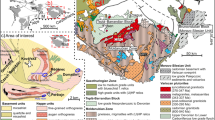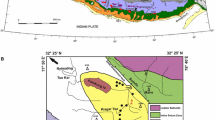Abstract
Within the Bergen Arcs of W Norway, Caledonian eclogite facies assemblages (T≥650°C, P≥15 kbar) have formed from Grenvillian granulites (T= 800–900°C, P≥10 kbar) along shear zones and fluid pathways. Garnets in the granulites (grtI: Pyr56–40 Alm45–25Gro19–14) are unzoned or display a weak (ca. 1 wt% FeO over 1000μm) zoning. The eclogite facies rocks contain garnets inherited from their granulite facies protoliths. These relict garnets have certain areas with compositions identical to the garnets in their nearby granulite, but can be crosscut by bands of a more Almrich composition (grtII: Pyr31–41Alm40–47Gro17–21) formed during the eclogite facies event. These bands, orientated preferentially parallel or perpendicular to the eclogite foliation, may contain mineral filled veins or trails of eclogite-facies minerals (omphacite, amphibole, white mica, kyanite, quartz and dolomite). Steep compositional gradients (up to 9 wt% FeO over 40 μm) separate the two generations of garnets, indicating limited volume diffusion. The bands are interpreted as fluid rich channels where element mobility must have been infinitely greater than it was for the temperature controlled volume diffusion at mineral interfaces in the granulites. The re-equilibration of granulite facies garnets during the eclogite facies event must, therefore, be a function of fracture density (deformation) and fluid availability. The results cast doubts on modern petrological and geochronological methods that assume pure temperature controlled chemical re-equilibration of garnets.
Similar content being viewed by others
References
Andersen T, Austrheim H, Burke EAJ (1990) Fluid inclusions in granulites and eclogites from the Bergen Arcs, Caledonides of W. Norway. Mineral Mag 54:145–158
Andersen T, Austrheim H, Burke EAJ (1991a) Fluid-induced retrogression of granulites in the Bergen Arcs, Caledonides of W. Norway: fluid inclusion evidencc from amphibolite-facies shear zones. Lithos 27:29–42
Andersen T, Austrheim H, Burke EAJ (1991b) Mineral-fluid melt interactions in high-pressure shear zones in the Bergen Arcs nappe complex, Caledonides of W. Norway: implications for the fluid regime in Caledonian eclogite-facies metamorphism. Lithos 27:187–204
Austrheim H (1987) Eclogitisation of lower crustal granulites by fluid migration through shear zones. Earth Planet Sci Lett 81:221–232
Austrheim H (1990) The granulite-eclogite facies transition: a comparison of experimental work and a natural occurrence in the Bergen Ares, western Norway. Lithos 25:163–169
Austrheim H (1991) Eclogite formation and the dynamics of crustal roots under continental collision zones. Terra Nova 3:492–499
Austrheim H, Griffin WL (1985) Shear deformation and eclogite formation within granulite-facies anorthosites of the Bergen Arcs, western Norway. Chem Geol 50:267–281
Austrheim H, Mørk MBE (1988) The lower continental crust of the Caledonian mountain chain: evidence from former deep crustal sections in western Norway. Nor Geol Unders Special Publ 3:102–113
Boundy TM, Fountain DM, Austrheim H (1992) Structural development and petrofabrics of eclogite facies shear zones, Bergen Arcs, Western Norway: implications for deep crustal deformational processes. J Mctamorphic Geol 10:1–21
Burton KW, O'Nions RK (1991) High-resolution garnet chronometry and the rates of metamorphic processes. Earth Planet Sci Lett 107:649–671
Chakraborty S, Ganguly J (1991) Compositional zoning and cation diffusion in garnets. In: Ganguly J (ed) Diffusion, atomic ordering, and mass transport (Advances in physical geochemistry, vol 8). Springer, Berlin Heidelberg New York
Cohen AS, O'Nions RK, Siegenthaler R, Griffin WL (1988) Chronology of the pressure-temperature history recorded by a granulite terrain. Contrib Mineral Petrol 98:303–311
Crank J (1975) The mathematics of diffusion, 2nd edn. Clarendon Press, Oxford
Dodson M (1973) Closure temperature in cooling geochronological and petrological systems. Contrib Mineral Petrol 40:259–274
Hollister LS (1969) Contact metamorphism in the Kwoiek Area of British Columbia: an end member of the metamorphic process. Geol Soc Am Bull 80:2465–2494
Jamtveit B, Bucher-Nurminen K, Austrheim H (1990) Fluid controlled eclogitisation of granulites in deep crustal shear zones, Bergen Arcs, Western Norway. Contrib Mineral Petrol 104:184–193
Jamtveit B, Carswell DA, Mearns EW (1991) Chronology of the high-pressure metamorphism of Norwegian garnet peridotites/pyroxenites. J Metamorphic Geol 9:125–139
Lasaga AC (1979) Multicomponent exchange and diffusion in silicates. Geochim Cosmochim Acta 43:455–469
Lasaga AC (1983) Geospeedometry: an extension of geothermometry. In: Saxena SK (ed) Kinetics and equilibrium in mineral reactions (Advances in physical geochemistry, vol 3). Springer, New York Berlin Heidelberg, pp 88–114
Lasaga AC, Richardson SM, Holland HC (1977) Mathematics of cation diffusion and exchange between silicates minerals during retrograde metamorphism. In: Saxena SK, Bhattacharji S (eds) Energetics of geological processes. Springer, Berlin Heidelberg New York, pp 353–388
Mezger K, Rawnsley X, Bohlen SR, Hanson GN (1991) U—Pb garnet, sphene, monazite, and rutile ages: implications for the duration of high-grade metamorphism and cooling histories, Adirondac Mts, New York. J Geol 99:415–429
Robinson P (1991) The eye of a petrographer, the mind of the petrologist. Am Mineral 76:1781–1810
Spear FS, Selverstone J (1983) Quantitative P-T paths from zoned minerals: theory and applications. Contrib Mineral Petrol 83:348–357
Spear FS, Selverstone J, Hickmott D, Crowley P, Hodges KV (1984) P-T paths from garnet zoning: a new technique for deciphering tectonic processes in crystalline terranes. Geology 12:87–90
Sturt BA, Skarpenes O, Ohanian AT, Pringle IR (1975) Reconnaissance Rb/Sr isochron study in the Bergen Arc system and regional implications. Nature 253:595–599
Thompson AB, Tracy RJ, Lyttle PT, Thompson JB Jr (1977) Prograde reaction history as deduced from compositional zonation and mineral inclusions in garnet from the Gassetts schist, Vermont. Am J Sci 277:1152–1167
Vance D, O'Nions RK (1990) Isotopic chronometry of zoned garnets: growth kinetics and metamorphic histories. Earth Planet Sci Lett 97:227–240
Walter JV, Orville PM (1982) Rate of metamorphism and volatile production and transport in regional metamorphism. Contrib Mineral Petrol 79:252–257
Author information
Authors and Affiliations
Rights and permissions
About this article
Cite this article
Erambert, M., Austrheim, H. The effect of fluid and deformation on zoning and inclusion patterns in poly-metamorphic garnets. Contr. Mineral. and Petrol. 115, 204–214 (1993). https://doi.org/10.1007/BF00321220
Received:
Accepted:
Issue Date:
DOI: https://doi.org/10.1007/BF00321220




